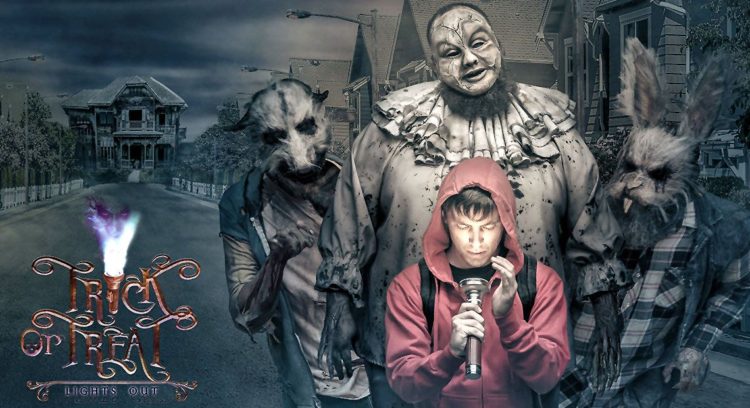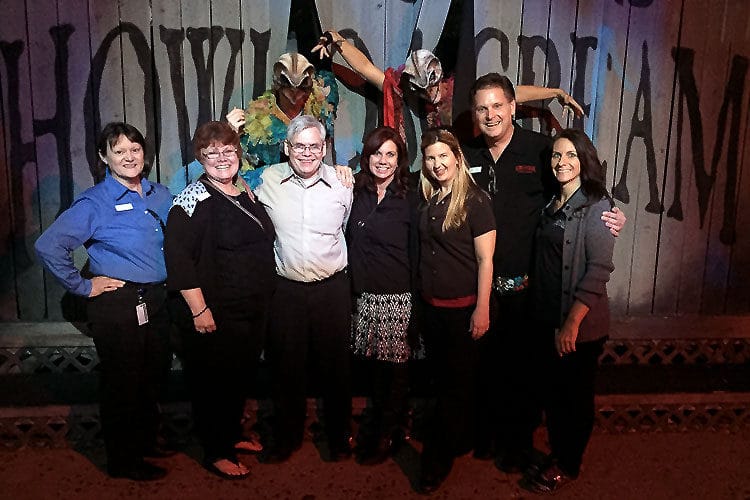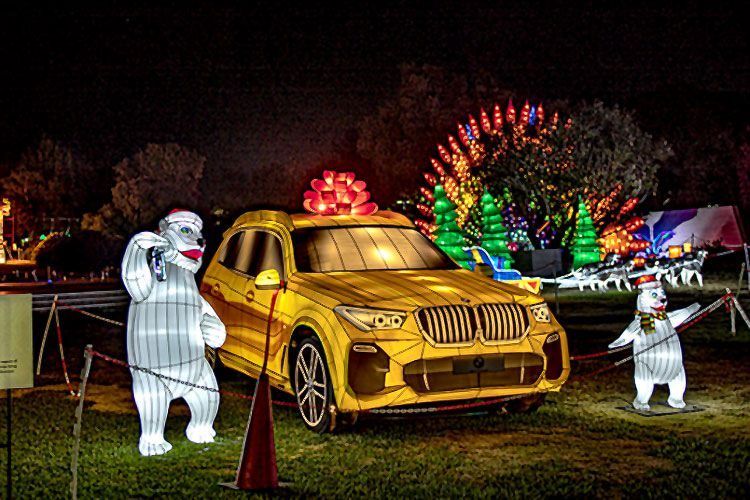Jon Cooke, Entertainment Designer at Knott’s Berry Farm, talks about how his team revitalized an older attraction headed for retirement into a top-producing event—using a flashlight!
During this past Halloween season, Knott’s Scary Farm unveiled a rich and integrated revisioning of its older, trick-or-treat maze, Trick-or-Treat: Lights Out. In the 2017 version of this attraction, guests armed with only a seemingly faulty flashlight, a stout heart, and a love of horror, entered the haunted home of the Green Witch and were plunged into terrors amid the total darkness.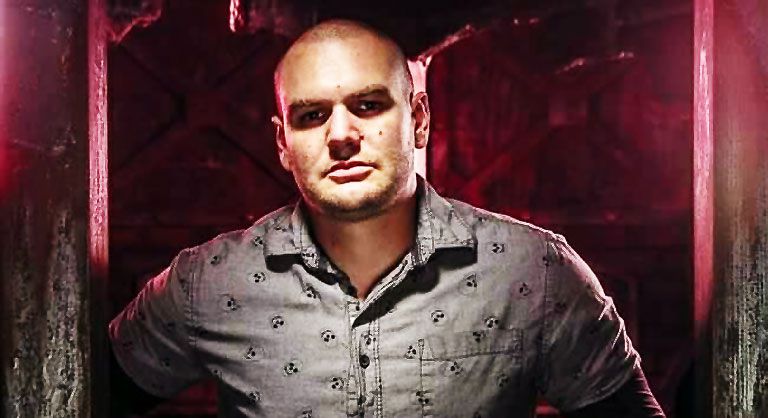
The maze revision succeeds due to integrating technology with story and purpose.
Reinventing a Classic but Tired Attraction
The Trick-or-Treat maze debuted in 2012 and is the oldest maze at Knott’s Scary Farm. We talked to Jon Cooke, Entertainment Designer at Knott’s, about the backstory of Trick-or-Treat: Lights Out. We wanted to hear about the challenges his team faced and the process that led to the re-invented maze. “This maze has been a fan favorite,” said Jon, “but it was tired. At the end of Haunt 2016, we sat down to talk about Haunt 2017. Typically, we retire two mazes every year, but that year we felt three mazes were at the point of retirement. We didn’t want to stretch our budget, resources, or workforce too thin by taking on three, new, full-blown mazes. Trick or Treat was a classic maze, but it felt tired. So, we asked ourselves how we could change [the maze] enough to revitalize it without rebuilding it,” he said. “That’s when we began kicking around the idea of bringing in the Torch Technology and integrating that system into this six-year-old maze. I immediately went to the Torch technology as a way to upgrade the Trick-or-Treat maze. We began experimenting with flashlights to see if it was feasible and operationally made sense in a large-throughput attraction. I’d seen flashlight mazes, but none that had to keep up with 1000+ people an hour going through,” Jon explained.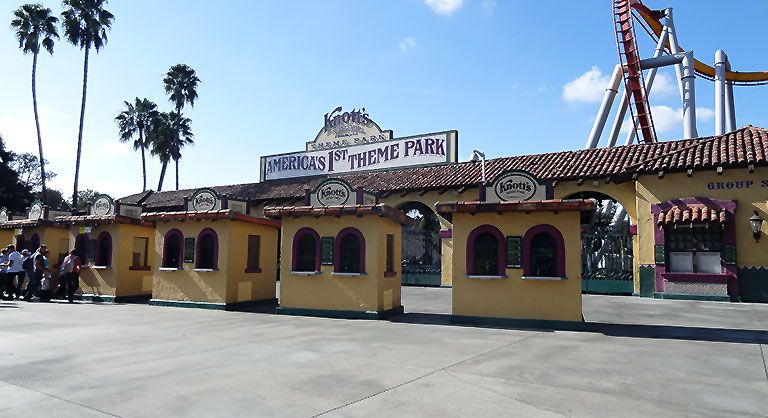
The Importance of Aligning Innovation with Story
“It was essential that how we revitalized the maze was aligned with the maze itself. This is important for people to be aware of—make sure the technology enhances the story,” said Jon. “Trick-or-Treat features retro Halloween experiences, so we had to keep that in mind in thinking about how to make the maze fresh without changing that.” The Trick-or-Treat maze is set in modern times and features an old abandoned house. “Every one of us [involved with the maze design] had the experience as a kid of investigating an abandoned house at night with a flashlight. The scariest part of that was, what if the flashlight goes out? It made sense to take the maze in that direction and bring these childhood memories to life. But, this time, the flashlights do go out, and the monsters do appear,” he emphasized. “When it came to operations and the logistics of implementing this, we’ve learned that any time you hand a guest something you want back, the exit needs to be close to the entrance, so the guests do the recycling for you. We used the same maze layout as Trick-or-Treat had always had. We looked at the throughput numbers from previous years and broke those down into hourly, and then we figured out how many guests were in the maze at any given time, on average. This gave us a ballpark number of how many flashlights we’d need, and we calculated that into our budget.” Jon then contacted Gantom and explored going beyond the flashlight concept and advancing the technology. Gantom is always interested in discovering new ways for its technology to impact the environment and be impacted by it. Quan Gan, Founder of Gantom Lighting & Controls, explained what happened next: “Knott’s approached us with a specific example of what they wanted to do—they asked us if the Torch could trigger an effect. Normal trigger mechanisms were already there, but they wanted the guest to point at something and activate it—almost like a laser gun or video game. This inspired us to upgrade our original Torch. We incorporated transmission from the Torch itself back to the scenery. When the guest points the Torch at a specific area, it may trigger some cool special effects within that scene. We want the guest to feel they’re a part of the experience and not just watching it like a story,” he explained.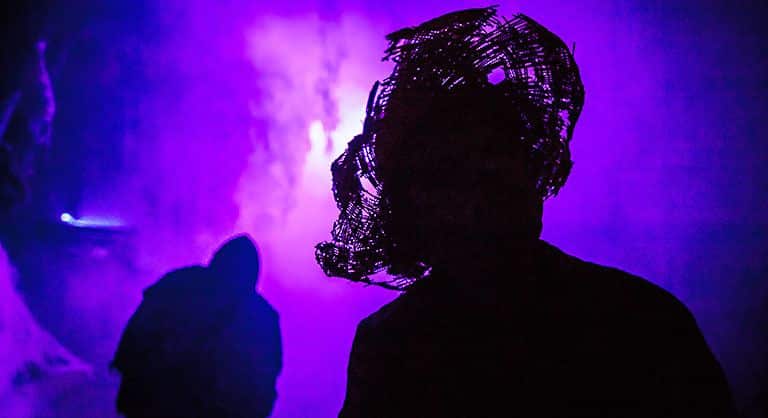 Jon agreed. “We didn’t want the flashlight to be a gimmick. We wanted to make sure the flashlight was just as important to the story as the characters and everything else. We were aware that the flashlights would communicate with the IR emitters to change colors, so we were curious about whether the flashlights could communicate to other sensors. We worked with our effects team and with Gantom to make sure the flashlights were transmitting to the environment. We were able to build the narrative rather than guests just being plunged into this dark haunted house with monsters in it,” he said.
“In the first couple rooms, there are no actors. It’s just the guests exploring this creepy old house. As they scan the rooms with the flashlight, they catch items moving. The flashlights allowed us to make things move, like out of the corner of your eye. As soon as the flashlight beam crossed a sensor, an animatronic or effect moves away and out of sight, as opposed to coming toward the guest. Our design built the suspense in those first three rooms, so when the first character appears, guests are fully immersed in the story. The flashlight added depth to the experience. It’s more than just a haunted house packed with monsters and a million pop-out scares. There’s a narrative that involves the guest,” he said.
“We wanted the flashlights to behave like normal flashlights in the outside scenes, but once guests stepped into the house, they become ‘defective.’ The transition communicates that the house is affecting the function of the flashlights function. As soon as guests leave the threshold of the house, the flashlights behave normally. It’s the energy in the house that’s causing the flashlights to malfunction,” Jon explained.
Gan added, “What we’re doing is taking decades-old, IR technology that’s in everybody’s remote control and we’re incorporating it into various forms of interaction. What you see in Trick-or-Treat: Lights Out is one iteration of that, one manifestation of a guest walking through a scene and being able to trigger effects.”
Jon agreed. “We didn’t want the flashlight to be a gimmick. We wanted to make sure the flashlight was just as important to the story as the characters and everything else. We were aware that the flashlights would communicate with the IR emitters to change colors, so we were curious about whether the flashlights could communicate to other sensors. We worked with our effects team and with Gantom to make sure the flashlights were transmitting to the environment. We were able to build the narrative rather than guests just being plunged into this dark haunted house with monsters in it,” he said.
“In the first couple rooms, there are no actors. It’s just the guests exploring this creepy old house. As they scan the rooms with the flashlight, they catch items moving. The flashlights allowed us to make things move, like out of the corner of your eye. As soon as the flashlight beam crossed a sensor, an animatronic or effect moves away and out of sight, as opposed to coming toward the guest. Our design built the suspense in those first three rooms, so when the first character appears, guests are fully immersed in the story. The flashlight added depth to the experience. It’s more than just a haunted house packed with monsters and a million pop-out scares. There’s a narrative that involves the guest,” he said.
“We wanted the flashlights to behave like normal flashlights in the outside scenes, but once guests stepped into the house, they become ‘defective.’ The transition communicates that the house is affecting the function of the flashlights function. As soon as guests leave the threshold of the house, the flashlights behave normally. It’s the energy in the house that’s causing the flashlights to malfunction,” Jon explained.
Gan added, “What we’re doing is taking decades-old, IR technology that’s in everybody’s remote control and we’re incorporating it into various forms of interaction. What you see in Trick-or-Treat: Lights Out is one iteration of that, one manifestation of a guest walking through a scene and being able to trigger effects.”

The Theme-Park Waltz: Walking the Fine Line Between Innovative and Throughput
“The theme park dance involves walking that fine line between innovation and throughput,” explained Jon. “No matter how amazing the experience is, guests don’t want to wait three hours to see it. Throughput was our concern with this new Trick-or-Treat maze—but we found we were able to keep up with all the other, standard, walk-through mazes. We noticed early on that when the lights go out, people slow down, so we increased the intensity of the flashlights in the first few rooms. The extra light helped people get moving. That was an important learning experience,” he commented. “There was a lesson, too, in how the actors performed in the pitch black with people flashing lights in their faces all night. What we did there was bring the intensity of the lights down when guests were about to come into contact with an actor.” In 2016, when the maze was its usual Trick-or-Treat maze, it was in the bottom tier of guests’ overall satisfaction with attractions. After it became Lights Out, it jumped to the second-highest attraction regarding satisfaction among guests. “It did amazing. It’s a testament to innovation and interactivity. That’s what people want. It’s essentially the same maze, but by thinking outside the box a little bit and integrating interactive technology, it sprung to the top of the pack. We continued the old story, but in a powerful new way: This house belonged to a witch, it’s been vacant all these years, and there’s a new force that’s awakened inside,” said Jon. “Some guests commented that they’d been through the maze 80 times and, this past year, they didn’t recognize it. That was cool. The flashlights motivate people to want to come through again and again, because guests see different things each time. Guests aren’t seeing the maze in a panoramic view but more intimately using the flashlight. Trick or Treat: Lights Out always had a line, even on the slow nights. In our geographic area, it’s a one-of-a-kind experience—which is what we, at Knott’s, always try to provide—because of the interactive flashlight.”
Gan agreed, “At Gantom, we’re always interested in adding new, interactive elements. Traditionally, Knott’s Trick-or-Treat was a walk-and-see type of show. Adding interaction that allows guests to change the behavior of a scene is completely new.”
“Some guests commented that they’d been through the maze 80 times and, this past year, they didn’t recognize it. That was cool. The flashlights motivate people to want to come through again and again, because guests see different things each time. Guests aren’t seeing the maze in a panoramic view but more intimately using the flashlight. Trick or Treat: Lights Out always had a line, even on the slow nights. In our geographic area, it’s a one-of-a-kind experience—which is what we, at Knott’s, always try to provide—because of the interactive flashlight.”
Gan agreed, “At Gantom, we’re always interested in adding new, interactive elements. Traditionally, Knott’s Trick-or-Treat was a walk-and-see type of show. Adding interaction that allows guests to change the behavior of a scene is completely new.”
Rave Reviews for Trick-or-Treat: Lights Out
Trick or Treat: Lights Out has been voted by guests and industry critics alike as one of the best haunts in Southern California. The Orange County Register gave Trick or Treat: Lights Out a ‘five skulls’ out of five skulls rating, stating, “This is a superb journey into psychological horror and will set off your jump-scares meter.” Escape Authority (escapeauthority.com) also gave Trick-or-Treat: Lights Out a rave review: “Perhaps the most traditional ‘vintage Halloween’ approach Knott’s has ever taken also results in one of its most satisfying story-driven haunts. Trick-or-Treat: Lights Out is just that—an adventure straight from our childhood that finds us going house to house collecting candy on All Hallow’s Eve. That is, of course, until we ring the wrong doorbell—the doorbell of that dark, spooky old house at the end of the street that the other kids claim is home to an evil witch, trapping us in a world of delightfully devilish, playful evil,” states the review on the Escape Authority website. “It’s never been so easy to become lost within the Trick-or-Treat storyworld—whether you want to or not.”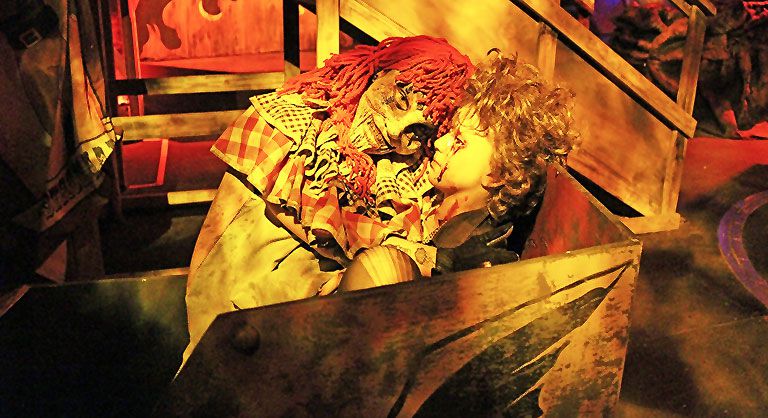
Key Takeaways:
The maze revision succeeds due to integrating technology with story and purpose. “It was essential that how we revitalized the maze was aligned with the maze itself. This is important for people to be aware of—make sure the technology enhances the story. Trick-or-Treat features retro Halloween experiences, so we had to keep that in mind in thinking about how to make the maze fresh without changing that.” Interactivity sells, but the story must support it. “We want the guest to feel they’re a part of the experience and not just watching it like a story” Stay away from gimmicks; there must be meaningful integration and consequences. “We didn’t want the flashlight to be a gimmick. We wanted to make sure the flashlight was just as important to the story as the characters and everything else. The flashlight added depth to the experience.” Throughput is a balancing act. “No matter how amazing the experience is, guests don’t want to wait three hours to see it.” The maze has a beginning (guests exploring with no monsters), a middle/conflict (monsters), and an end (escaping the house and walking through the garden). “Our design built the suspense in those first three rooms, so when the first character appears, guests are fully immersed in the story… It’s the energy in the house that’s causing the flashlights to malfunction.” Experiment and adjust to your guests. “We noticed early on that when the lights go out, people slow down, so we increased the intensity of the flashlights in the first few rooms. The extra light helped people get moving… What we did there was bring the intensity of the lights down when guests were about to come into contact with an actor.” Build for repeatability. “Guests aren’t seeing the maze in a panoramic view but more intimately using the flashlight.”About The Speaker
Jon Cooke
Jon Cooke is involved in Entertainment Design at Knott’s Berry Farm. He’s overseen some of the most interactive mazes at Knott’s Scary Farm including ‘Special Ops: Infected’ (2014-2016), ‘Paranormal Inc’ (2015-2016), and ‘Shadow Lands’ (2016).
